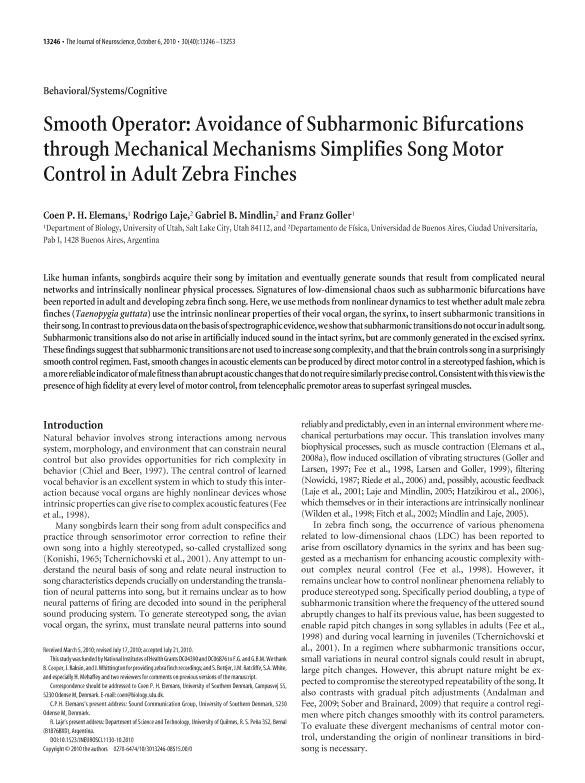Mostrar el registro sencillo del ítem
dc.contributor.author
Elemans, Coen P. H.
dc.contributor.author
Laje, Rodrigo

dc.contributor.author
Mindlin, Bernardo Gabriel

dc.contributor.author
Goller, Franz

dc.date.available
2023-03-22T13:45:43Z
dc.date.issued
2010-10
dc.identifier.citation
Elemans, Coen P. H.; Laje, Rodrigo; Mindlin, Bernardo Gabriel; Goller, Franz; Smooth operator: Avoidance of subharmonic bifurcations through mechanical mechanisms simplifies song motor control in adult zebra finches; Society for Neuroscience; Journal of Neuroscience; 30; 40; 10-2010; 13246-13253
dc.identifier.issn
0270-6474
dc.identifier.uri
http://hdl.handle.net/11336/191377
dc.description.abstract
Like human infants, songbirds acquire their song by imitation and eventually generate sounds that result from complicated neural networks and intrinsically nonlinear physical processes. Signatures of low-dimensional chaos such as subharmonic bifurcations have been reported in adult and developing zebra finch song. Here, we use methods from nonlinear dynamics to test whether adult male zebra finches (Taenopygia guttata) use the intrinsic nonlinear properties of their vocal organ, the syrinx, to insert subharmonic transitions in their song. In contrast to previous dataonthe basis of spectrographic evidence, we show that subharmonic transitions do not occur in adult song. Subharmonic transitions also do not arise in artificially induced sound in the intact syrinx, but are commonly generated in the excised syrinx. These findings suggest that subharmonic transitions are not used to increase song complexity, and that the brain controls song in a surprisingly smooth control regimen. Fast, smooth changes in acoustic elements can be produced by direct motor control in a stereotyped fashion, which is amorereliable indicator of male fitness than abrupt acoustic changes that do not require similarly precise control. Consistent with this view is the presence of high fidelity at every level of motor control, from telencephalic premotor areas to superfast syringeal muscles.
dc.format
application/pdf
dc.language.iso
eng
dc.publisher
Society for Neuroscience

dc.rights
info:eu-repo/semantics/openAccess
dc.rights.uri
https://creativecommons.org/licenses/by-nc-sa/2.5/ar/
dc.subject
birdsong
dc.subject
complex
dc.subject
models
dc.subject.classification
Otras Ciencias Físicas

dc.subject.classification
Ciencias Físicas

dc.subject.classification
CIENCIAS NATURALES Y EXACTAS

dc.title
Smooth operator: Avoidance of subharmonic bifurcations through mechanical mechanisms simplifies song motor control in adult zebra finches
dc.type
info:eu-repo/semantics/article
dc.type
info:ar-repo/semantics/artículo
dc.type
info:eu-repo/semantics/publishedVersion
dc.date.updated
2023-03-15T10:05:03Z
dc.journal.volume
30
dc.journal.number
40
dc.journal.pagination
13246-13253
dc.journal.pais
Estados Unidos

dc.description.fil
Fil: Elemans, Coen P. H.. University of Utah; Estados Unidos
dc.description.fil
Fil: Laje, Rodrigo. Universidad Nacional de Quilmes; Argentina. Universidad de Buenos Aires; Argentina. Consejo Nacional de Investigaciones Científicas y Técnicas; Argentina
dc.description.fil
Fil: Mindlin, Bernardo Gabriel. Universidad de Buenos Aires; Argentina. Consejo Nacional de Investigaciones Científicas y Técnicas; Argentina
dc.description.fil
Fil: Goller, Franz. University of Utah; Estados Unidos
dc.journal.title
Journal of Neuroscience

dc.relation.alternativeid
info:eu-repo/semantics/altIdentifier/doi/http://dx.doi.org/10.1523/JNEUROSCI.1130-10.2010
dc.relation.alternativeid
info:eu-repo/semantics/altIdentifier/url/https://www.jneurosci.org/content/30/40/13246
Archivos asociados
